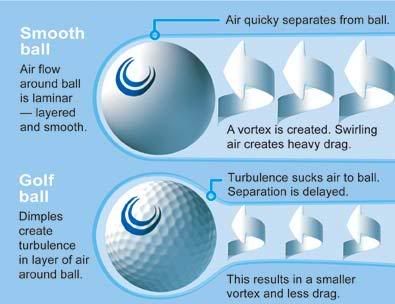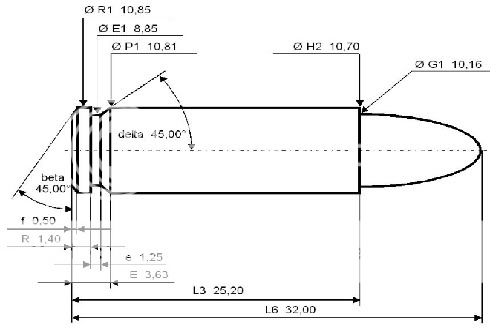Basic Information
CoreThe central core of the bullet is a 'blended metal' core, made out of a mixture of metals. The base metals used in these formulations are usually a very fine powder. Copper, tungsten, and brass are examples of some of the base powdered metals used to date. These powdered metals are mixed with a binder such as tin, zinc, or a polymer such as nylon. Once the powdered metal(s) and binder(s) are mixed, they are pressed or molded into the final projectile core form, and in some cases sintered. The advantage of using a blended metal bullets is that when the material goes through a hard target, such as a bullet proof vest, the mixture and hardness of the bullets allows for the dispersion of heat to primarily enter the hard objects- this reducing the amount of energy exerted on the bullet itself. When entering a soft target, like living tissue, the bullets mixture instead directs heat towards itself, disintegrating the 'bond' or in reality the binder of the bullet, and causing the primary bullet materials to expand rapidly, and at their accelerated speed, cause large wound cavities or damage in soft targets.
Full Metal Jacket The full metal jacket of the rifle consists of a copper covered jacket, designed to work in the same manner that every other full metal jacket works. The copper piece is designed to reduce barrel wear and reduce the bullet build up inside the weapon, and be removed by the surface of whatever it contacts. In addition to this, a fine layer of polytetrafluoroethylene, or Teflon. Teflon has a friction ratio with steel of nearly 0.01, making it one of the slickest surfaces on the planet. Because of this, each bullet is coated in a fine spray of this, allowing the bullet to exit the barrel with as little wear to the actual barrel as possible. This essentially allows the barrel to be able to support the extreme velocity achieved by the bullet, and to reduce the event of jams and to reduce the number of cleaning required. In addition to this, it allows for a bullet of it's kind to reduce any problems associated with it's high velocity and high density and immalleability.
DimplesGolf ball dimples have been known to increase the velocity of things- footballs, golf balls, basketballs, cars, but a marginal amount. While a golf ball on average increases it's velocity by close to double what it usually would with it's kind energy backed behind, most other objects do not respond this way due to their lack of surface of area facing the air (oblong shapes have differing surface areas than a sphere which has the same all around). Because of this, the dramatic increase of 54% increase in distance is felt, but this is not translated into a 54% velocity increase. Still, the dimples do provide an increase of velocity, this resulting in an 8% increase of velocity.
 Conic Shape
Conic ShapeThe
Conic Shape of the improved model is almost exactly the same shape as the
.460 S&W. Despite the differences in the rounds, even their sizes (although this is almost nonexistant, as both rounds are interchangeable in .460 S&W revolvers), their similar diameter represents a close to ideal shape already made. While this slight difference does not necessarily produce exactly ideal shapes, it's ease in design and manufacture allows it to keep the weapon price at a relatively low price without many more improvements, and removes the aspect of having to design an entirely new bullet design.
Parent Case The round is based off of the
.454 Casull, almost entirely. The round size, propellant, and casing is almost identical. The weight, or mass, is roughly the same, with the differentiation of density being different, being around the same. The bullet, obviously, differs from the original round by the previous notifications- such as the full metal jacket, the latex, the blended metal, conic shape, and the golf ball dimples. The bullet instead preforms extraordinarily efficiently, allowing it to surpass the original casing, while still keeping it's primary format and the original advantages.
Polygonal RiflingPolygonal rifling (pə-lĭg'ə-nəl) is a type of rifling wherein the traditional lands and grooves are replaced by "hills and valleys" in a rounded polygonal pattern, usually a hexagon or octagon.
Polygons with a larger number of edges provide a better gas seal in relatively large diameter polygonally rifled bores.
A number of advantages are claimed by the supporters of polygonal rifling. These include:
Not compromising the barrel's thickness in the area of each groove as with traditional rifling.
Providing a better gas seal around the projectile as polygonal bores tend to have a slightly smaller bore area, which translates into more efficient use of the combustion gases trapped behind the bullet,[3] slightly greater (consistency in) muzzle velocities and slightly increased accuracy.
Less bullet deformation, resulting in reduced drag on the bullet when traveling through the barrel which helps to increase muzzle velocity.
Reduced buildup of copper or lead within the barrel which results in easier maintenance characteristics.
Prolonged barrel life.
However, precision target pistols such as those used in Bullseye and IHMSA almost universally use traditional rifling, as do target rifles. The debate among target shooters is almost always one of cut vs. button rifled barrels, as traditional rifling is dominant. Polygonal rifled barrels are used competitively in pistol action shooting, such as IDPA and IPSC competitions.
Part of the difference may be that most polygonal rifling is produced by hammer forging the barrel around a mandrel containing a reverse impression of the rifling. Hammer forging machines are tremendously expensive, far out of the reach of custom gunsmiths (unless they buy pre-rifled blanks), and so are generally only used for production barrels by large companies. The main advantage of a hammer forging process is that it can rifle, chamber, and contour a bored barrel blank in one step.
Modified Round- 10.5 inch Polygonal barrel (From five feet up)
Effective range- 200 meters
Maximum range- 500 meters
Velocity- 610 m/s (2001 feet/second)
Mass- 16 grams
Energy- 2978 Joules (2196 foot/pounds)




